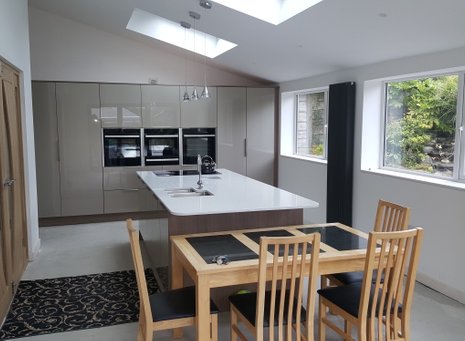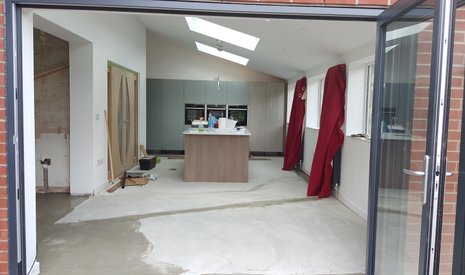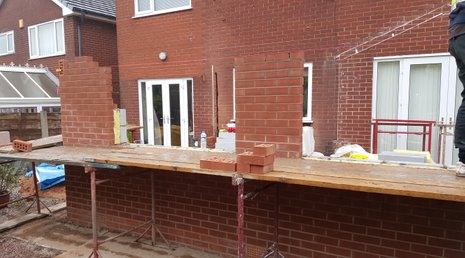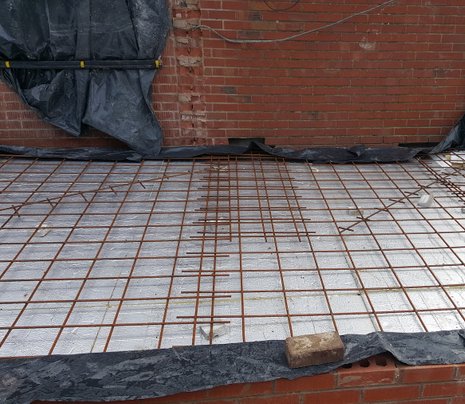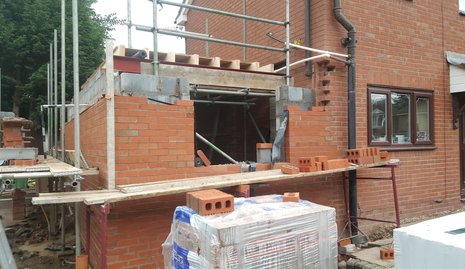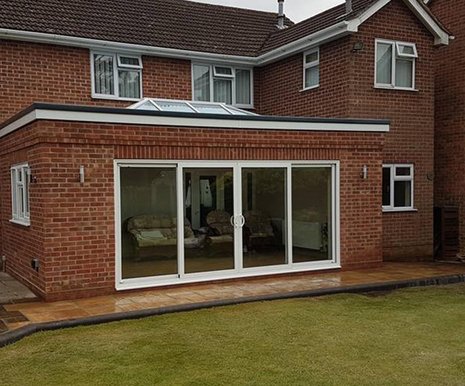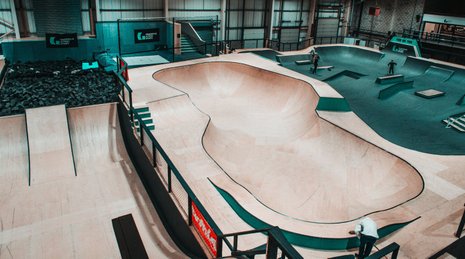01254 492329
Info@Buildersalliance.co.uk
08.00 TO 18.00
Monday to Saturday
13 Railway Road, Darwen
Lancashire BB3 2RG
Builders in Manchester
Builders in Manchester
Double-storey extensions in Manchester: how to cost, plan and design a two-storey extension. Double-storey extensions Manchester, done well, are a cost-effective alternative before moving house when you’re inclined to size up severely. They can add valuable living space but extra sleep space too. Plus, double-storey extensions will change interiors that are not suitable for contemporary life – a shortage of bathrooms to balance bedrooms upstairs and, on the ground floor.
Building new rooms upstairs and down that thoroughly blend into your home is the key to a successful double-storey extension in Manchester. The main offices of your home should be accessible from the main hall or circulation space in an open-plan layout, as well as from the landing. Rooms or zones with related uses – like the kitchen and the dining space – work strongly grouped next to each other.
Lastly, a two-storey extension is a cost-effective choice, giving you the square footage for your pound than a single-storey extension in Manchester, and enabling you to transform the look and feel of both upstairs and down. Ideal for small homes and growing families, it's the best way to increase the living area and add a bedroom.
IS A DOUBLE STOREY EXTENSION ACTUALLY BETTER THAN A SINGLE STOREY?
‘An additional storey doubles the amount of extra living space but, more importantly, it also gives excellent value for money compared to building a single-storey extension in Manchester. A roof is required whether you want a single- or double-height design, so you are only paying for added floor joists and extended walls to accomplish much more space.
Value is also defined by supply and demand, so you should think about your local market, too. You could even maximise the space gains by considering three storeys – obtaining permission is more likely if other homes in the street have similar additions.
A DOUBLE-STOREY EXTENSION ADD VALUE TO YOUR HOME?
If space is the reason you want to extend your home, look at homes nearby properties with the same footprint your house will have following the extension. If you compare this with the average price per square metre of your extension, you can figure out whether your plans will increase the value of your property. Be conscious that there is a limit to how much value you can add to your home, identified as the ceiling value.
If you are struggling with your space and wondering what kind of extension will work for you, or just what to do with your budget, check out the Extensions page.
HOW TALL CAN A DOUBLE STOREY EXTENSION BE?
The main restriction on two-storey extensions is ordinarily the roof height. Planning policy needs an extension to be considerate to the existing house, so the height of its ridge and eaves should not be higher than the existing roof.
Where a building has low ceilings, it can be hard to build an extension tall enough to combine two full (2.4m) storeys. However, there are answers, such as using lower ceiling heights in the new rooms, particularly at first-floor level, partly integrating upstairs bedrooms into the roof area, or setting the extension down moderately in the ground.
A shallow pitched roof can cover a large extension without standing too tall, but this is not always pleasant, especially on a period building or in a delicate location such as a conservation area. A flat roof can cover a range of any size but is not usually deemed acceptable for a two-storey extension, unless part of an overall contemporary design project of significant architectural merit.
WHERE SHOULD A DOUBLE STOREY EXTENSION BE LOCATED?
At the rear: The rear of a property is ordinarily the best place to add a two-storey extension to a semi-detached property or terraced house.
At the side: Wherever a property has a large outdoor area, as numerous houses on a street corner do, there will be the potential to extend over two storeys at the side. In some instances, an extension can wrap around multiple sides of an existing property.
On multiple sides: Maximising space? Joining two storeys on various parties is also desirable. Get, authorised development rights only refer to rear double-storey extensions – so you’ll want to get permission if you plan to site the home extension in Manchester elsewhere.
PLANNING A DOUBLE STOREY EXTENSION
Preparing a double-storey extension in careful detail is necessary if you are to complete the build on time and budget – and if it is to satisfy all your expectations. From finding out whether you need planning permission – expected with two storeys – or can extend under permitted development rights – not so likely but possible – to find a builder experienced in constructing two-storey extensions, decent planning will save you time, trouble and money later.
ASSURE THE FLOW BETWEEN THE DOUBLE STOREY EXTENSION AND ORIGINAL HOUSE WORKS
The flow within new and old spaces in a double-storey Manchester house extension should be as flowing as possible for your expansion to be successful. If you've planned a kitchen extension, you may want to access it from the primary hallway via broader than usual doors.
Furthermore, ensuring floor levels in the new house extension match those of the old house – or at least the corridor it leads off from – will make the new rooms feel like a regular part of the house.
ADDING A DOUBLE STOREY EXTENSION TO A SEMI-DETACHED HOUSE
We've covered the rules for extending to the rear of home – terraced or semi-detached or detached in our sector on planning permission and permitted development. But what if you desire to add a two-storey extension to the side of a semi-detached house, whether into a space that's currently a garage or unused garden area?
Here, it is debatable that a two-storey extension can be built under permitted development rights, mainly if the home extension is within 2m of the property's perimeter. So, whether you are plotting to build from scratch at the side of your home or to use the grounds of the existing garage to make a new room above, it is enough to seek advice first, then permission from the council's planning department.
WHAT UNWISHFUL IMPLICATIONS MIGHT THE EXTENSION'S POSITION HAVE?
Recognize that the position of the extension will change views, privacy, garden access, and which windows will be shaded. It’s also essential to consider where the new space will join the existing room plan.
Often, part of an existing room has to be reduced to create the circulation space needed. Think about the effect of light reduction to neighbours’ windows when constructing an extension to your home as they may complain. If you haven’t taken this into account, your neighbour may reject your building project – even if you’ve been given planning permission.
MAKING THE DESIGN OF A DOUBLE STOREY EXTENSION'S ROOF RIGHT
The roof will undoubtedly be limited by planning in terms of its height and form, but you should make every effort to secure it, like the doors and windows and other structural details, complements the materials and principles of those of the existing house, all while planning precisely how light will reach the measurements of the rooms that have been extended.
CHOOSING THE BEST DOORS AND WINDOWS FOR YOUR TWO STOREY EXTENSION
Windows and doors will have a big impression on the finished look of your two storey Manchester extension, and not just in words of materials, frame colours and frame widths. The windows and doors sizes, positions and shapes should both contrast entirely with the current house or complement those of the first house as precisely as possible, both down and upstairs.
SELECTING EXTERIOR MATERIALS FOR YOUR DOUBLE STOREY EXTENSION
The way, proportions and materials utilised for your extension may be limited by what your local officials will agree to. An experienced architect will be able to suggest what you can and can’t do. Exterior elements should be chosen to either equal those of the original house – think reclaimed bricks to create your Manchester two-storey extension look like it’s steadily been there.
The first idea is often to add more space with a double-storey extension in the same way as the existing property.
PLANNING THE INTERIOR LAYOUT UPSTAIRS
Choosing what to do with the upstairs rooms of your two-storey house extension is about getting the scale right, which mainly depends on the size that your new and improved house will be.
You could do without an extra bathroom upstairs. Are you enlarging a three-bedroom house up to a four-bedroom house with your new home extension? The other key factor to work on is the layout of the hallway upstairs and entrance to the rooms – try to make the corridor as wide as it was before.
PLANNING THE INTERIOR LAYOUT DOWNSTAIRS
The internal layout is an essential part of the double-storey extension planning. Should you choose to create a series of smaller spaces, or open-plan or a mixture of the two? Consider your requirements and how you'll use the area thoroughly before you start. Building an extension with a kitchen might imply you're designing an open-plan kitchen diner and living space Dodge turning rooms into corridors by developing new circulation routes: principal rooms, such as the living room and kitchen, should always be entered from the main hallway.
Fun Facts about Manchester
Manchester United - Football Club is a known football club based in Old Trafford, Greater Manchester, England, that plays in the Premier League, the top rank of English football.
Manchester City - Football Club is a British football club based in Manchester, that plays in the Premier League, the top Rank of English football.
Manchester Climbing Centre is built in a beautiful converted Victorian church with lots of climbing fun! There are areas of climbing for experienced climbers and instructed sessions available.
Breakout is a real-life escape room game. A different experience that will leave you craving more. Using brainpower and common sense you have 60 minutes to escape a locked room.
The Manchester Evening News - is a localised daily newspaper reporting Greater Manchester in North West Region England.
Graystone - is a world-class destination for kids and athletes, inspiring change in action sports; scooter, BMX, skate, trampoline, ski, snowboard, gymnastics, climbing.
Manchester’s tropical rainforest - Where ancient spirits stir, temples crumble, and mini-golf reigns supreme.
Frog and the Bucket - Manchester’s first and longest-running Alternative Comedy Venue, showcasing the very best in international and national comedy Monday through Saturday.



